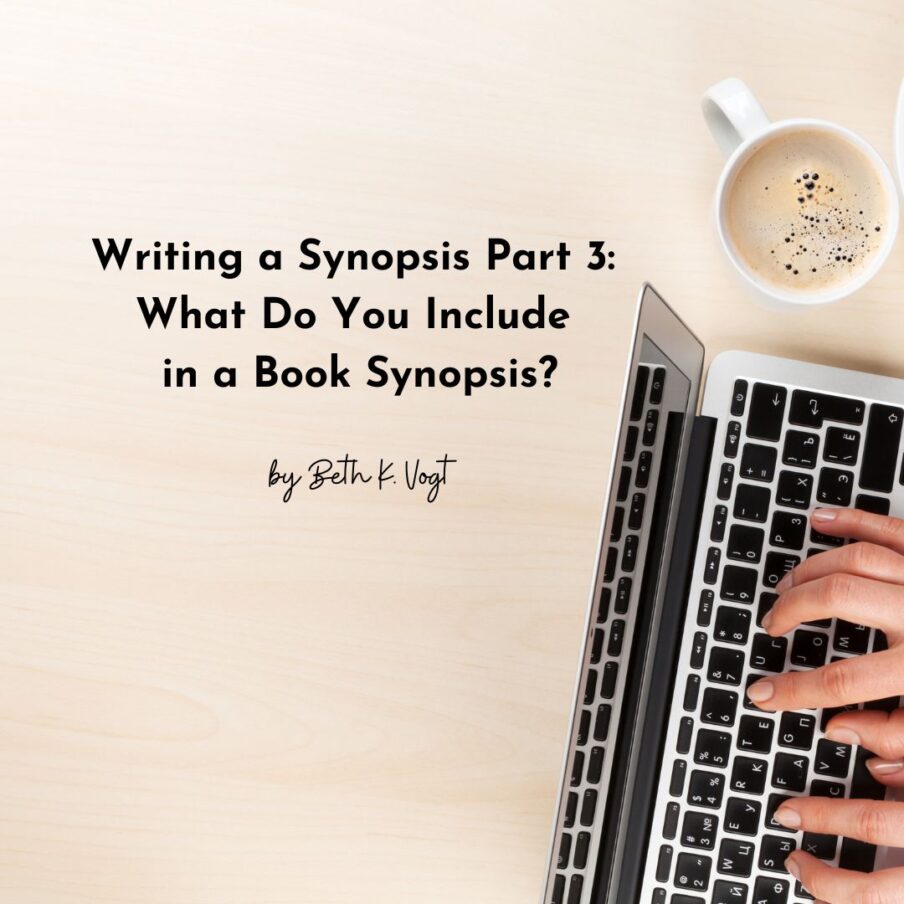by Beth K. Vogt, @bethvogt
I’m back – and yes, I’m talking about writing a synopsis again.
In my blog post Writing a Synopsis Part 1: The Overview Paragraph, I discussed how an overview paragraph is often overlooked in a book synopsis, as well as why it’s so important, and how to write one.
Last month, in Writing a Synopsis Part 2: Understanding the Different Types of Synopses, I detailed the differences between a one-paragraph synopsis, a one-page synopsis, and a long synopsis.
Today, I’m focusing on what: what specifics do you include in a book synopsis?
It’s important to remember every book you write has two plots: the external plot and the internal plot. The external plot focuses on the obstacles your main characters face. The internal plot focuses on the emotional and spiritual changes your main characters go through.
Which Plots Do You Include in Your Book Synopsis?
When you’re writing a one-paragraph synopsis, utilize your overview paragraph and focus on your external plot. Include a hook for your first sentence and then two, maybe three more sentences that give an overview of your book. You can end the paragraph with a compelling question.

For a one-page synopsis you focus only on the main plot. No subplot characters. Your focus is also on the external plot – the obstacles your main characters face in your book. Of course, you start with your overview paragraph, and then the next paragraph introduces either your hero or your heroine and their Inciting Incident. The next paragraph switches to the other main character and their Inciting Incident. You alternate back and forth between the two characters, highlighting the obstacles they are facing – often moving from bad, badder, baddest – and forcing them to choose how they are going to respond to these obstacles. For an editor and/agent, you must include how the book ends. Don’t end the synopsis with a question like “Will Harry and Sally end up together?”
For a long synopsis that can be three to five pages or more, you have more room, more word count, to tell the story. Of course, the focus is on the main characters and the external plot. This still must be done well. You can also choose to weave in your subplot, if you have one, as well as choose to weave in the internal plot for your main characters, i.e., how they change emotionally and/or spiritually.
Next month, I’ll wrap up this blog series with some tips to make your synopsis shine.

The award-winning Thatcher Sister Series by Beth K. Vogt, published by Tyndale House, is described as a “Little Women gone wrong” collection of novels highlighting complicated sister relationships in the style of This is Us. NYT bestselling author Lisa Wingate said, “With tenderness and skill, Beth Vogt examines the price of secrets, the weight of tragic loss, and the soul-deep poison of things left unsaid.” The series includes Things I Never Told You, Moments We Forget, and The Best We’ve Been. Unpacking Christmas: A Thatchers Sisters Novella, was released in November 2022 by Never Door Press.

Beth K. Vogt believes God’s best often waits behind the doors marked “Never.” She started out in fiction writing award-winning contemporary romances, including Somebody Like You, which was selected as one of Publishers Weekly’s Best Books of 2014. Beth transitioned to women’s fiction with her Thatcher Sister Series, which she calls “a Little Women gone wrong” collection of books highlighting complicated sister relationships. Published by Tyndale House, the series includes Things I Never Told You, which won the 2019 AWSA Award for Contemporary Novel of the Year, Moments We Forget, and The Best We’ve Been. Beth is also a Christy Award winner, an ACFW Carol Award winner, and a RITA® finalist. An established magazine writer and former editor of the leadership magazine for MOPS International, Beth blogs for Learn How to Write a Novel and The Write Conversation, and also enjoys speaking to writers group and mentoring other writers. She lives in Colorado with her husband Rob, who has adjusted to living with imaginary characters and is also one of Beth’s most trusted brainstormers for her novels. Visit Beth at bethvogt.com.

